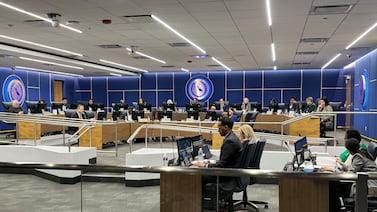In just a single generation, the college degree has become a major fault line in American politics.
Just 20 years ago, Al Gore and George W. Bush split the 100 most-educated counties in the nation. This year, Joe Biden won 83 of them. Donald Trump, meanwhile, won nine out of 10 of the least-educated counties — those where fewer than 16% of adults have a college degree.
Strong shifts in voting based on educational level are happening in nearly every state and in most counties. Take two counties with the same name: the Jefferson counties of Colorado and of Ohio.
Colorado’s Jefferson County has moved 26 points toward the Democrats in presidential elections since 2000. Here, 44% of residents 25 and older hold a bachelor’s degree, well above the national average of about 31%.
This Jefferson County sits on the western edge of the Denver metro area, touting itself as the “Gateway to the Rocky Mountains,” and is home to companies like Coors Brewing and Lockheed Martin. Its residents voted solidly for Bush in both 2000 and 2004. In 2008, the county went for Barack Obama and has voted for the Democrat in presidential elections ever since.
Contrast that with the Jefferson County of Ohio, which has swung 45 points toward Republicans over the past two decades. Just over 15% of its residents 25 and older have a bachelor’s degree, well below the national average.
The county, a former steel stronghold in eastern Ohio along the Ohio River, voted for Gore, John Kerry, and then Obama (once). Since then, it’s gone for Republicans.
The suburban mindset
Talk to people who live in these counties, and higher education doesn’t always leap to the forefront of the conversation about what’s changing. But you can quickly hear how it plays into all kinds of issues that shape the identity and politics of a place — what jobs are there to do, how much money can people earn, which generations are moving in and which ones are moving out.
In Colorado, the rhetoric of the Republican Party is now simply out of step with the suburban mindset, said State Rep. Colin Larson, a Republican who grew up in Jefferson County and now represents it.
His party’s stark, socially conservative positioning doesn’t play well here, he said, especially with his constituents who are 45 and younger. More late Generation Xers and millennials are now at stages in their lives where they’ve saved up enough money and are moving to the suburbs, said Larson, who is 33.
There’s a real generational shift on issues like gay rights and climate change. When he knocks on doors, he said, he regularly hears about those policies. People tell him they don’t plan to consider voting for a party that seems stuck in the past.
Here’s how a college education fits in, said Larson, who graduated from Colorado College and started an independent coffee shop before running for office:
People who are college educated “have more of a tendency to be movable in politics,” he said, “because they get outside of their communities more.”
Over just two decades, Jefferson County has gone from being the beating heart of Colorado’s Republican Party to being a nationally watched bellwether to being pretty reliably Democratic, said Eric Sondermann, a columnist for the news journal ColoradoPolitics.
Larson says he’s watched a “meteoric implosion” of his party in Jefferson County. Of the county’s seven representatives in the Colorado House, he’s now the only Republican.
Diminishing industries
In Ohio, Jefferson County was once dominated by industries like steel mills, paper mills, glass factories, and potteries. The prevalence of unions here helped drive the county’s past affiliation with Democrats, said Charles Green, a volunteer historian and genealogist at the Jefferson County Historical Association.
Now, those industries are gone.
When young people get out of high school, Green said, there are few jobs for them here if they don’t go to college. And if they do go to college, they don’t come back. They move to the bigger cities, places like Columbus and Cleveland.
There are a couple of major industries left — including Titanium Metals, up north in Toronto, and Barium & Chemicals, in Steubenville. Beyond that, he says, there are some satellite businesses and machine shops but nothing big like there used to be.
Green, who is 83, has lived in Jefferson County his whole life. He served in the U.S. Marines. He worked in quality control for many years at Titanium Metals, and he’s been volunteering with the historical association since 1997. Over the years he took some college courses — at Wittenberg University and at what used to be known as Jefferson County Technical Institute. And he studied metallurgy through the American Society of Metals. But he never completed a college degree.
He doesn’t always vote with the same party, he said. Both this year and four years ago, though, he went with Trump.
When asked about Jefferson County politics, Green first touted local history. The 19-room county museum where he gives tours showcases the famous people born here. There’s Dean Martin, there’s Dorothy Sloop (the song “Hang on Sloopy” is said to be about her). And then there’s one local legend, Green said, everyone here supports: Edwin McMasters Stanton, the war secretary under Abraham Lincoln.
As it happens, Stanton spent the first decades of his political life as a Democrat — before switching to become a Republican.
A version of this story originally appeared in Open Campus. Open Campus, a Chalkbeat partner, is a nonprofit news organization focused on higher education.






